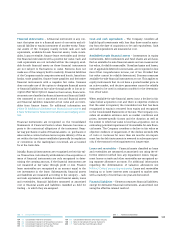Siemens 2011 Annual Report Download - page 263
Download and view the complete annual report
Please find page 263 of the 2011 Siemens annual report below. You can navigate through the pages in the report by either clicking on the pages listed below, or by using the keyword search tool below to find specific information within the annual report.
153 D. Consolidated Financial Statements 273 E. Additional information
158 D. Consolidated Statements of Changes in Equity
160 D. Notes to Consolidated Financial Statements
266 D. Supervisory Board and Managing Board
154 D. Consolidated Statements of Income
155 D. Consolidated Statements of Comprehensive Income
156 D. Consolidated Statements of Financial Position
157 D. Consolidated Statements of Cash Flow
Associated companies and jointly controlled entities –
Companies in which Siemens has the ability to exercise signif-
icant influence over operating and financial policies (general-
ly through direct or indirect ownership of % to % of the
voting rights) and jointly controlled entities are recorded in
the Consolidated Financial Statements using the equity meth-
od of accounting and are initially recognized at cost. The fol-
lowing policies equally apply to associated companies and
jointly controlled entities. Where necessary, adjustments are
made to bring the accounting policies in line with those of
Siemens. The excess of Siemens’ initial investment in associ-
ated companies over Siemens’ ownership percentage in the
underlying net assets of those companies is attributed to cer-
tain fair value adjustments with the remaining portion recog-
nized as goodwill. Goodwill relating to the acquisition of asso-
ciated companies is included in the carrying amount of the in-
vestment and is not amortized but is tested for impairment as
part of the overall investment in the associated company.
Siemens’ share of its associated companies’ post-acquisition
profits or losses is recognized in the Consolidated Statements
of Income, and its share of post-acquisition movements in eq-
uity that have not been recognized in the associates’ profit or
loss is recognized directly in equity. The cumulative post-ac-
quisition movements are adjusted against the carrying
amount of the investment in the associated company. When
Siemens’ share of losses in an associated company equals or
exceeds its interest in the associate, Siemens does not recog-
nize further losses, unless it incurs obligations or makes pay-
ments on behalf of the associate. The interest in an associate
is the carrying amount of the investment in the associate to-
gether with any long-term interests that, in substance, form
part of Siemens’ net investment in the associate. Intercompa-
ny results arising from transactions between Siemens and its
associated companies are eliminated to the extent of Siemens’
interest in the associated company. Siemens determines at
each reporting date whether there is any objective evidence
that the investment in the associate is impaired. If this is the
case, Siemens calculates the amount of impairment as the
difference between the recoverable amount of the associate
and its carrying value. Upon loss of significant influence over
the associate, Siemens measures and recognises any retain-
ing investment at its fair value. Any difference between the
carrying amount of the associate upon loss of significant in-
fluence and the fair value of the retaining investment and
proceeds from disposal is recognised in profit or loss.
Foreign currency translation – The assets, including good-
will, and liabilities of foreign subsidiaries, where the function-
al currency is other than the euro, are translated using the
spot exchange rate at the end of the reporting period, while
the Consolidated Statements of Income are translated using
average exchange rates during the period. Differences arising
from such translations are recognized within equity and re-
classified to net income when the gain or loss on disposal of
the foreign subsidiary is recognized. The Consolidated State-
ments of Cash Flow are translated at average exchange rates
during the period, whereas cash and cash equivalents are
translated at the spot exchange rate at the end of the report-
ing period.
The exchange rates of the significant currencies of non-euro
countries used in the preparation of the Consolidated Finan-
cial Statements were as follows:
Year-end exchange
rate € quoted into
currencies
specified below
Annual average rate
€ quoted into
currencies
specified below
September , Fiscal year
Currency ISO Code
U.S. Dollar USD 1.350 1.365 1.399 1.358
Chinese
Renminbi CNY 8.633 9.133 9.148 9.226
British Pound GBP 0.867 0.860 0.871 0.869
Indian Rupee INR 66.119 61.247 63.181 62.754
Foreign currency transaction – Transactions that are de-
nominated in a currency other than the functional currency of
an entity, are recorded at that functional currency applying
the spot exchange rate at the date when the underlying trans-
actions are initially recognized. At the end of the reporting pe-
riod, foreign currency-denominated monetary assets and lia-
bilities are re-valued to functional currency applying the spot
exchange rate prevailing at that date. Gains and losses arising
from these foreign currency revaluations are recognized in
net income. Those foreign currency-denominated transac-
tions which are classified as non-monetary are remeasured
using the historical spot exchange rate.
Hyperinflationary accounting – Financial statements of for-
eign subsidiaries, where the functional currency is the cur-
rency of a hyperinflationary economy, are adjusted to reflect
changes in general purchasing power. In such instances, all
items which are recognized on the Consolidated Statements
























